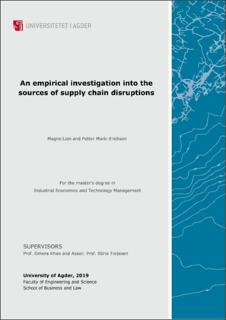| dc.description.abstract | Firms are facing a vast array of risks which can cause disruptions to the normal operation of their supply chains. Managers striving to prepare for and overcome these disruptions have a broad selection of literature and risk reports at their disposal when assessing risks to their supply chain. These risk reports and academic works provide differentiated and compelling answers to what are the most pressing risks to supply chains, but are they accurate? This study aims at providing managers with an empiricalfoundation on what the main sources of supply chain disruptions have been the last decade by addressing the following research question:What have been the main sources of supply chain disruptions over the last decade, and do observed patterns correspond with expectations put forward in the scholarly literature and the risk management communities?Based on a content analysis of 11 504 articles from the Financial Times archive from 2009-2018, 445 articles describing sources of supply chain disruptions were retrieved. The samples were later analysed using statistical methods. The results of this investigation revealed that disruptions originating from within the supply chain were in sum the most prevalent. The majority of these disruptions were associated with risks that have traditionally been the concerns of supply chain managers. These risks include operational struggles at suppliers that are unable to deliver the desired quantity and quality, as well as challenges with forecasting demand and navigating the legal and bureaucratic process that emerge from operating a complex global supply chain across multiple regions. The study also revealed that supply chain disruptions stemming from risk sources external to the supply chain such as asset price collapse, natural hazards, terrorism and political turmoil have accounted for a relatively constant number of supply chain disruptions over the last decade. This observation is contrary to the seemingly increasing focus on these risks by the global community. However, even though there has not been an increase in disruptions caused by external events, catastrophic events still stood out as one of the biggest threats facing supply chains. Catastrophic incidents encompass high impact-low probability events including natural hazards such as earthquakes and hurricanes together with man-made acts both deliberate e.g. war and terrorism, and unintentional such as fires. Somewhat contrary to the attention given o acts of terrorism in the wake of the 9/11 attacks, disruptions associated with acts of terrorism constituted a surprisingly small number of the supply chain disruptions, with the vast majority of disruptions related to catastrophic events attributed to natural hazards. Lastly, the findings showed that disruptions originating from risks associated with information and communication technology, in particular, cyber-crime and unplanned IT outage, have been an increasingly common source of supply chain disruptions during the decade in conjunction with the advancing digitalisation of supply chains.Comparing the findings against the focus of academia and the risk management communities it is apparent that the strong focus on risks external to the supply chain is somewhat warranted given the frequent occurrences of catastrophic events that disrupt supply chains. However, the study revealed that too much attention has been given to these high-profile events, and in the process the more mundane risks facing supply chains have received less attention. As a consequence,these risks continue to pose a significant threat to the performance of supply chains. The findings highlight the importance of using several sources of information when assessing risks to supply chains. No single source of information, may it be scholarly literature, risk reports or internal reporting are able to grasp all the current, and future, patterns of supply chain disruptions by themselves. Managers should keep this in mind when identifying and assessing the risks to their supply chain. Diligence in seeking out alternative sources of information on supply chain risks can aid in creating a more advantageous supply chain risk management process and foster greater resilience in supply chains. | nb_NO |

